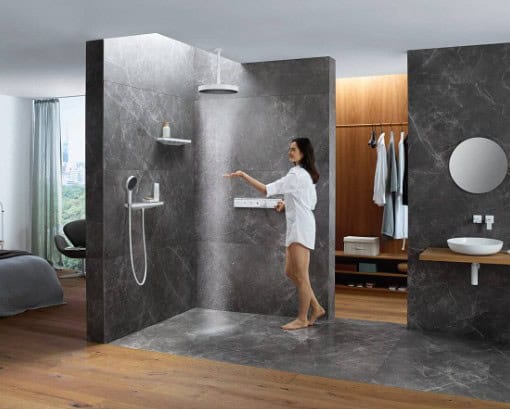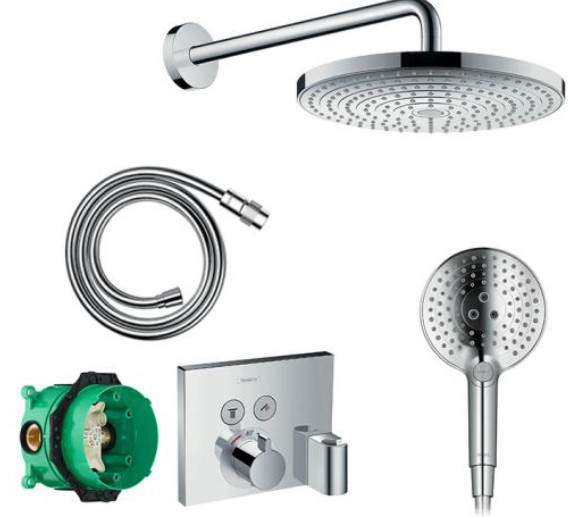Hansgrohe, a well-known German bathroom and kitchen fixtures manufacturer, produces high-quality and durable products, so its shower valves should be reliable and long-lasting. However, be prepared should you find your Hansgrohe shower valve leaking.
Your Hansgrohe shower valve can leak because of damaged seals, loose or improperly connected components, corrosion, cracked or faulty valve body, and improper installation. You can also trace the cause of this issue to high water pressure or age and wear.
To ensure you do not waste water and restore your shower valve’s functionality, let’s discuss these causes and their fixes in depth.

Hansgrohe Shower Valve Leaking (Causes & Fixes!)
| Problem | Possible Causes | Recommended Fixes | |
| 1. | Damaged Seals | Age and wear Mineral deposit accumulation Improper maintenance | Clean seals with vinegar and water solution Replace worn-out seals |
| 2. | Loose or Improperly Connected Components | Improper installation Wear and tear High water pressure | Tighten loose connections Reconnect improperly connected components Replace faulty parts |
| 3. | Faulty Cartridge | Age and regular use Mineral buildup Sediment accumulation Poor water quality | Replace the cartridge |
| 4. | Cracked or Faulty Valve Body | Physical damage Corrosion High water pressure | Replace the whole valve body |
| 5. | Improper Installation | Loose connections Inadequate sealing Misalignment | Address any installation problems |
| 6. | High Water Pressure | Pressure regulator problems Municipal water supply or private water system issues | Install a water pressure regulator |
| 7. | Age and Wear | Normal deterioration Lack of maintenance Water quality issues Temperature fluctuations | Replace the damaged parts or the entire shower valve |
Note
Before repairing or replacing faulty parts, stop the water supply to your shower.
1. Damaged Seals
Hansgrohe shower valves have silicone or rubber seals positioned within the valve assembly to create a tight seal, thus preventing water from escaping where different parts of the valve meet.
Unfortunately, seals naturally degrade over time from water exposure, temperature fluctuations, and regular use. They can also harden and lose their flexibility from mineral deposit accumulation.
You can also damage the seals and reduce their effectiveness through abrasive scrubbing and using harsh chemicals.
Fix
Remove the handle and trim pieces to access and inspect the valve. Look for tears, cracks, hardness, or any visible deterioration on the seals around the inlet and outlet connections, cartridge, and trim components.
Clean the seals with vinegar and water solution to remove mineral deposits. After soaking the seals in this mixture, scrub them gently.
Replace the seals if they are rigid and show signs of damage.
2. Loose or Improperly Connected Components
A Hansgrohe shower valve features various components and connections responsible for regulating water flow and temperature. These include inlet and outlet pipes, fittings, or the valve itself.
Water can escape through gaps or openings in the valve if you do not fasten or connect these components correctly. For instance, an improperly seated or secured cartridge assembly contributes to leaks, and so can the pipes delivering hot and cold water to the valve.
Besides not installing these connections and components correctly, wear and tear can make them deteriorate, leading to loose connections. High water pressure also exerts added stress on them.
Fix
Examine the inlet and outlet pipes, seals, gaskets, and cartridge assembly for any signs of loose or improperly connected components. Tighten loose connections with the appropriate wrench, ensuring all connections are snug but not excessively tight.
In addition, if you find any improperly connected components, reconnect them correctly. Replace damaged seals and gaskets with new ones designed explicitly for your Hansgrohe shower valve model.
3. Worn Out Cartridge
When it comes to the components of a shower valve, the cartridge is among the core components. It controls the mixing of hot and cold water, ensuring you achieve the desired temperature and flow rate.
Therefore, ensuring it stays in good condition is essential. However, your Hansgrohe shower valve cartridge can succumb to deterioration due to regular use, temperature changes, and water pressure, leading to a loss of its sealing capabilities.
Mineral buildup can also hinder its smooth operation and cause it to wear out faster. Furthermore, tiny particles and debris from your water supply can clog the cartridge.
Your water supply may also contain impurities or aggressive chemicals that can damage the cartridge over time.
Fix
With the valve exposed, observe the cartridge’s operation as you adjust the temperature and flow. If the cartridge is visibly damaged or the valve continues to leak, the cartridge is likely faulty.
In that case, find a suitable replacement and install it. Hansgrohe 94282000 3/4-Inch Thermostatic Cartridge (View on Amazon) is a replacement part for thermostatic trim with volume control, a thermostatic trim with volume control and diverter, a thermobalance 1, 2, and 3, and ecostat shower trims.
4. Cracked or Faulty Valve Body
The valve body houses the internal workings of the valve, and if it’s compromised, it can lead to water leaks. The valve body can withstand water pressure and temperature changes because it is often crafted with durable materials like metal.
However, accidental impacts, mishandling, or rough installation can make it crack or faulty. Moreover, prolonged exposure to moisture and the chemicals in water can cause corrosion, weakening the valve body.
Furthermore, high water pressure can place excessive stress on the valve body, causing it to develop cracks or faults over time.
Fix
Replacing the entire valve body is the most effective solution for a cracked or faulty valve body.

5. Improper Installation
Although Hansgrohe shower valves are high-quality, performing products, you must install them correctly to ensure long-term functionality and prevent leaks. Improper installation can cause even the best valves to develop issues.
For instance, improperly tightened connections between the valve and water supply lines can lead to water leakage. Water seepage can also occur if you do not use appropriate sealing materials or techniques during installation.
You can also create gaps where water can escape if you misalign components. Furthermore, your shower valve can develop cracks or defects if installed wrongly or handled roughly.
Fix
- Ensure all components, including the valve body and trim, are properly aligned and fit together snugly. Adjust and tighten as needed.
- Securely tighten loose connections.
- Use thread sealant or sealing tape as specified by Hansgrohe’s installation guidelines.
- Before attempting a DIY installation, ensure you can handle the task at hand. If you don’t, hire an experienced plumber with expertise in Hansgrohe valves.
6. High Water Pressure
Exposing your Hansgrohe shower valve to exceptionally high water pressure places extreme stress on its parts. If your home’s pressure exceeds the recommended range, the seals and gaskets within the valve compress excessively, leading to leakage, and the cartridge gets strained, thus wearing off prematurely.
Excessive pressure can also lead to water leaks at joints, connections, and even through gaps in the valve assembly.
Common reasons for high water pressure include:
- Higher-than-normal water pressure in the municipal water supply, especially in certain areas or during peak usage times.
- Fluctuations in water pressure in a private well system due to the well’s pump settings.
- A malfunctioning or improperly adjusted pressure regulator letting in water at a high pressure to your home.
- A faulty or aging water heater interfering with your plumbing system functioning.
Fix
Install a pressure regulator at your home’s primary water supply line. Also, monitor and adjust your pressure regulator as needed to maintain the correct pressure level.
7. Age and Wear
The cartridge will eventually wear down or develop defects. In addition, you may find the metal components within the valve getting corroded or rusted, compromising their integrity. Sediment accumulation also contributes to the shower valve wearing off.
While wear and tear is expected, some things can make your shower valve deteriorate faster. These are:
- Frequent use.
- Poor water quality, high mineral content, and hard water.
- Frequent temperature changes in the valve stress the seals and gaskets.
- Lack of maintenance. Issues will go unnoticed and unfixed for much longer if you fail to inspect your Hansgrohe shower valve regularly, thus accelerating wear.
Fix
Carefully inspect the valve and its components. If only a few parts are worn off, replace them. However, if it is irreparable, get and install a new Hansgrohe shower valve.

How Do I Change A Hansgrohe Shower Cartridge?
This section covers the general steps for replacing a shower cartridge in a Hansgrohe shower valve. However, note that the steps needed to change a Hansgrohe shower cartridge can vary depending on the specific model.
1) Stop Water Supply
Turn off both the hot and cold water supply to your shower to ensure no water flows to the valve.
2) Remove The Handle And Trim
Use a screwdriver or Allen wrench to remove the handle handle adapter and the sleeve to expose the cartridge and the valve body. After that, take out the bonnet nut.
3) Remove the Old Cartridge
Next, position the handle and handle adapter on the shower valve stem, then turn it counter-clockwise approximately 1/4 once the the stop is successfully contacted. After that, lift your Hansgrohe shower valve out of the valve body.
4) Install The New Cartridge
For a normal installation, place the cartridge into the valve, ensuring the “hot side” marking is oriented to the left. On the other hand, for a reversed installation, position the cartridge in a way that the markings for the “hot side” are on the right.
Ensure the cartridge securely fits into the valve for all installations. Also, align the keys on the cartridge’s sides with the slots on the valve’s sides.
Once the cartridge is in, install and tighten the bonnet nut by hand, followed by the O-ring. Next, Slide the sleeve over the cartridge, valve body, and O-ring.
5) Reassemble The Trim Plate And Handle
Put the trim plate back and secure it to the bracket using the two screws. Also, reinstall and secure the handle. Make sure both parts are correctly aligned and functioning.
6) Turn On The Water Supply
Slowly restore your shower’s water supply and check for leaks. No leaks indicate success.
7) Test Your Shower
Turn on the shower to check the flow and temperature of the water. Adjust the water temperature and flow accordingly.
Summary of Hansgrohe Shower Valve Leaking
A leaking Hansgrohe shower valve can frustrate you, but with the right approach and basic plumbing knowledge, you can diagnose and repair the problem yourself. With this guide, you can identify and address the cause of the leak in your Hansgrohe shower valve.
Here are other related topics:
